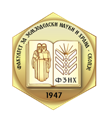CHARACTERIZATION OF HONEY: DETERMINATION OF METAL AND SUGAR CONTENT
Keywords:
AAS, Honey, HPLC, RID, SugarsAbstract
In this study, five samples of honey (4 from various beekeepers and 1 from a local supermarket) were analyzed to determine the presence of Pb, Fe, Mn, Al, Cu, Cr, Zn, Cd, As, Ni and Se content using atomic absorption spectrometry. Samples were collected from the following locations: 2 from Skopje, 2 from Kumanovo and 1 from Preshevo, Srbia. HPLC was applied to determine sugars in honey samples. Acid and moisture were also determined. The average values of concentration were from 0.033 to 0.055 mg/kg, 0.610to 2.498 mg/kg, 0.052 to 0.377 mg/kg, 2.133 to 3.474 mg/kg, 0.060 to 1.034 mg/kg, 0.005to 0.019 mg/kg, and 0.067 to 0.085 mg/kg for Pb, Fe, Mn, Al, Cu, Cr, and Zn, respectively. Cadmium was determined in one sample (0.040 mg/kg), while the presence of arsenic, nickel and selenium were not observed. The total amount of reductive sugars was within the standard value of min 60 g/100 g honey. The moisture was from 16.6 to 17.6% (max 20%). The acid content was recorded from 9 to 28mEq/1 kg honey (max 50mEq/1 kg honey). The results were compared with the safety standards established from the Ministry of Agriculture, Forestry and Water Economy. In general, the analyzed parameters are within the standards and honey can serve as good dietary source.



